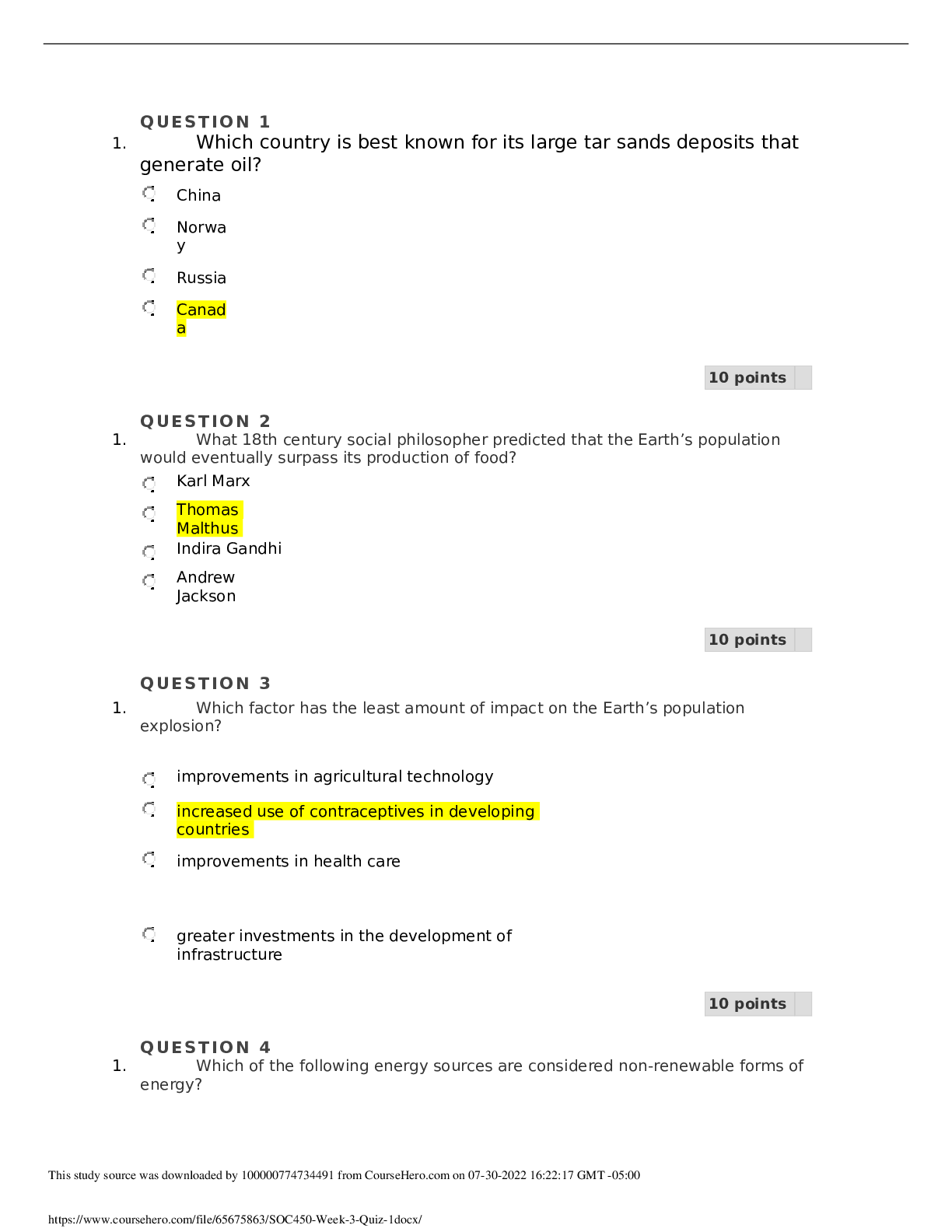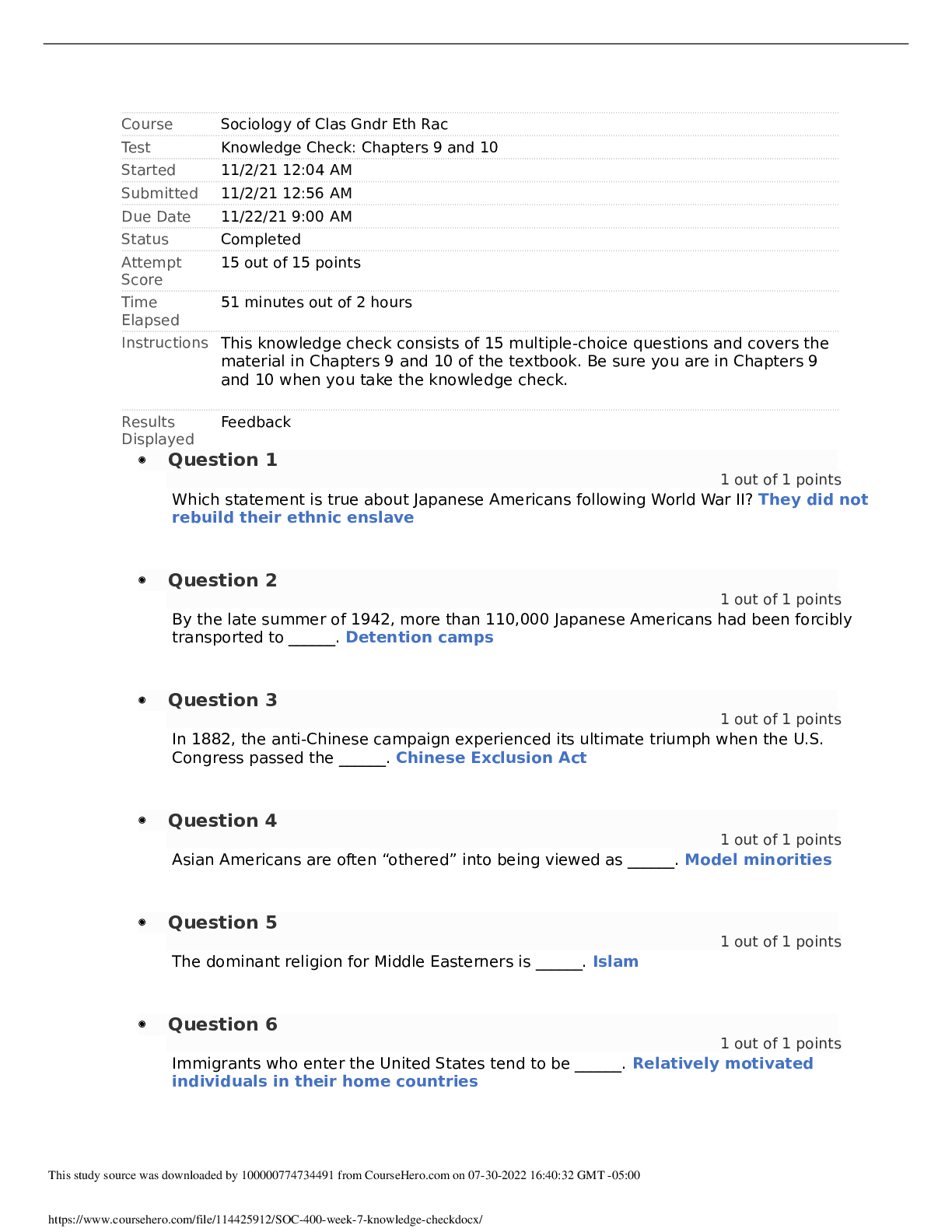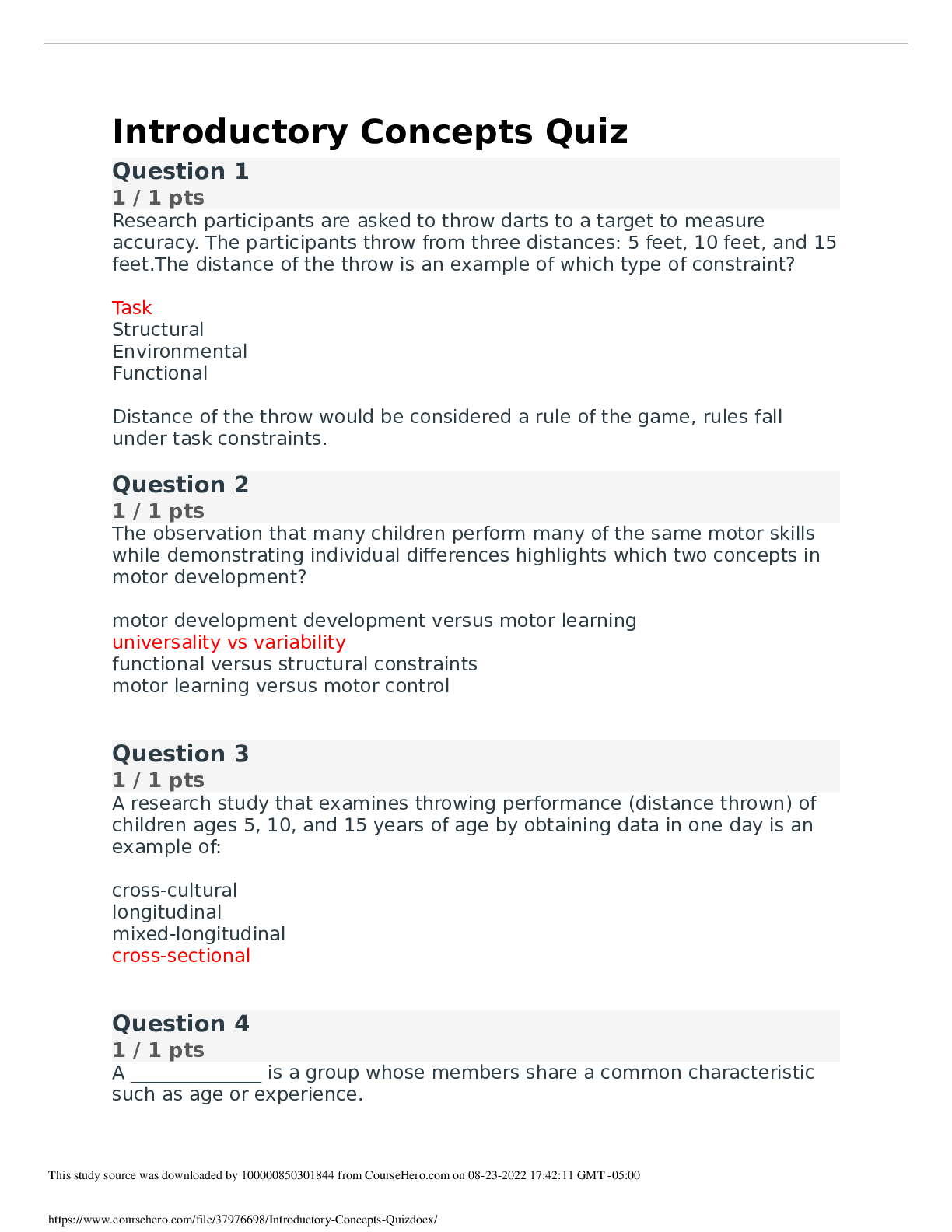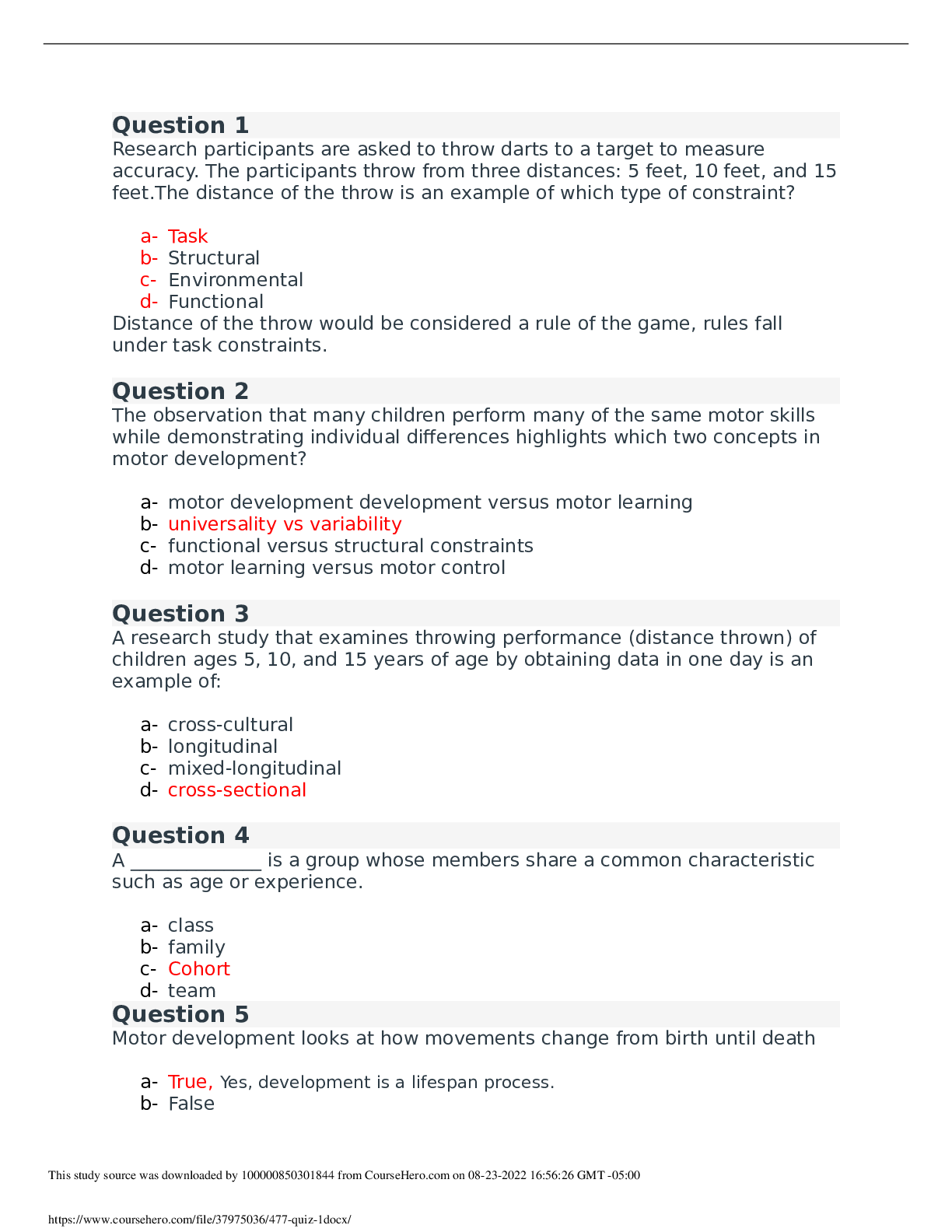Health Care > Quiz > UC Course Portal SP1 BS in Health Sciences HSCI320 Medical Sociology 001, SP1_Week 4 Quiz 4_Part 1. (All)
UC Course Portal SP1 BS in Health Sciences HSCI320 Medical Sociology 001, SP1_Week 4 Quiz 4_Part 1. Grade 27 out of 30_90%
Document Content and Description Below
UC Course Portal ▶︎ SP(1) 2017 ▶︎ BS in Health Sciences ▶︎ HSCI320 Med Sociology (001) SP1 2017 ▶︎ Week 4 ▶︎ Quiz 4 Medicalization is: Select one: a. The process where an in... dividual falls sick, goes to the doctor, and seeks b. A process where previously non-medical problems are defined and treate c. A concept which is not health care/medical related, but rather refers to the identifying stakeholders in a given situation. d. Purely about the shift in expectation from birthing at home to delivering at e. None of the above. Page: 198 A process where previously non-medical problems are d problems. Expanding reliance on new technologies has promoted a shift away from _____ patient’s oral account of his or her medical history. Select one: a. Folk medicine. b. Biographical medicine. c. Hereditary medicine. d. Verbal medicine. e. None of the above. Page: 234 Biographical medicine. QUIZ NAVIGATION Show one page at a time Finish review 1 2 3 4 5 6 7 8 9 10 11 12 13 14 15 16 17 18 19 20 21 22 23 24 25 26 27 28 29 30 Question 3 Question 4 In Mark 0 out of 1 Question 5 __________________ has become the dominant form of health care delivery in companies as third-party payers important in both bolstering medicalization thro services and a constraint in placing limitations on those services. Select one: a. Managed care. b. Fee-for-service. c. Medicare/Medicaid. d. All of the above. e. None of the above. Page: 199 Managed care. Dissatisfaction with the doctor-patient relationship is heavily dependent on one’ Select one: a. Gender. b. Culture. c. Race. d. Social class. e. None of the above. Page: 232 Social class. Which model of interaction is the norm in most doctor–patient interactions? Select one: a. Activity-passivity. b. Guidance-cooperation. c. React-revise. d. Mutual participation. e. None of the above. Page: 240 Mutual participation. Question 6 Question 7 Question 8 Distress may not be only physical; purely ____________ needs can trigger a vi Select one: a. Sociological. b. Psychological. c. Metaphysical. d. All of the above. e. None of the above. Page: 219 Psychological. Which is NOT a barrier to communication between doctors and patients? Select one: a. Age. b. Gender. c. Culture. d. Socioeconomic status. e. None of the above. Page: 229-230 None of the above. Physicians have to take on a variety of roles to induce patient adherence to the NOT a role? Select one: a. Educator. b. Salesperson. c. Cheerleader. d. Detective. e. None of the above. Page: 220 None of the above. Question 9 Question 10 In Mark 0 out of 1 Question 11 Male physicians tend to misdiagnose ______________ in female patients. Select one: a. Heart attack. b. Stroke. c. Anxiety. d. Cancer. e. None of the above. Page: 226 Heart attack. _______________ is where the deviants are temporarily exempted from norma privileges, provided that they seek help in order to rid themselves of their devian Select one: a. Conditional legitimacy. b. Unconditional legitimacy. c. Illegitimacy. d. Forgiveness. e. None of the above. Page: 208 Conditional legitimacy. The traditional identifying criteria for disease do NOT include: Select one: a. The patient’s experience of subjective feelings of sickness. b. The finding by the physician through examination and/or laboratory tests has a disordered function of the body. c. The patient’s symptoms conforming to a recognizable clinical pattern. d. The patient’s significant other’s identification of a “sick pattern.” e. All of the above. Page: 188 The patient’s significant other’s identification of a “sick pa Question 12 Question 13 Question 14 A person may desire to retain the sick role more or less permanently because o _______________, which is the exemption from normal obligations and the gai accorded to the sick. Select one: a. Primary reward. b. Secondary gain. c. Tertiary exemptions. d. Primary reaction. e. None of the above. Page: 193 Secondary gain. Mary Boulton and her colleagues explain that the influence of social class on th best understood in terms of: Select one: a. Social distance. b. Social space. c. Power and space. d. All of the above. e. None of the above. Page: 226 Social distance. The patient-physician relationship involves mutuality in the form of behavioral e power of the parties are ______________. Select one: a. Balanced. b. Equal. c. Unequal. d. Unknown. e. None of the above. Page: 194 Unequal. Question 15 Question 16 Question 17 People with middle and upper socioeconomic status tend to be more ________ in the physician–patient encounter. Select one: a. Aggressive. b. Consumer-oriented. c. Focused on getting well. d. Disease-focused. e. None of the above. Page: 221 Consumer-oriented. Processes such as crime and mental illness which disrupt the social order are: Select one: a. Functional. b. Dysfunctional. c. Unnecessary. d. Rare. e. None of the above. Page: 190 Dysfunctional. A major barrier to effective communication lies in the differences between physi respect to: Select one: a. Status. b. Education. c. Training. d. Authority. e. All of the above. Page: 223 All of the above. Question 18 Question 19 In Mark 0 out of 1 Question 20 “A state or condition of suffering as the result of a disease or sickness” defines: Select one: a. The sick role. b. Illness. c. Disability. d. Disease. e. None of the Above. Page: 188 Illness. People who have various types of physical deformities fall into which category o Select one: a. Abominations of the body. b. Blemishes of individual character. c. Disability of the form and mind. d. Feeling of lack of control. e. All of the above. Page: 211 Abominations of the body. The ___________________ model applies to the management of chronic illnes the doctor as a full participant in controlling the disease. Select one: a. Activity-passivity. b. Guidance-cooperation. c. React-revise. d. Mutual participation. e. None of the above. Page: 220 Mutual participation. Question 21 Question 22 Question 23 The shift toward consumerism in health care means patients have more status However, this relationship is significantly affected by an external influence: Select one: a. Third-party payers. b. Social class. c. The state. d. Religious groups. e. All of the above. Page: 233 Third-party payers. ___________________ argue that physician–patient interaction falls into one o Select one: a. Haug and Lavin. b. Parsons. c. Hayes-Bautista. d. Szasz and Hollender. e. All of the above. Page: 220 Szasz and Hollender. Which is NOT a criticism of Parsons’s sick-role theory? Select one: a. Behavioral variation. b. Types of diseases. c. Behavioral modification. d. The patient–physician relationship. e. All of the above are criticisms. Page: 200 Behavioral modification. Question 24 Question 25 Question 26 The sick role is oriented toward which group? Select one: a. Upper class. b. Upper and middle class. c. Middle class. d. Lower class. e. All of the above. Page: 204 Middle class. Who was one of the leading proponents of labeling theory? Select one: a. Emile Durkheim. b. Max Weber. c. Sigmund Freud. d. Howard Becker. e. All of these were proponents. Page: 205 Howard Becker. _________________ is the notion that, since the work of the physician is for the tend to impute illness to their patients rather than to deny it and risk overlooking Select one: a. Choice v. health theory. b. Health care paternalism. c. The medicalization belief. d. The medical decision rule. e. None of the above. Page: 219 The medical decision rule. Question 27 Question 28 Question 29 Parsons’s concept of the sick role seems to typically apply only to _________ d Select one: a. Chronic. b. Acute. c. Infectious. d. Catastrophic. e. None of the above. Page: 202 Acute. The term ___________ has been characterized as an adverse physical state, c dysfunction within an individual. Select one: a. The sick role. b. Illness. c. Disability. d. Disease. e. None of the Above. Page: 188 Disease. Parsons’s concept of the sick role is based on the assumption that: Select one: a. Illness is normal and routine. b. Being sick is not a deliberate and knowing choice of the sick person. c. There are different types of illnesses resulting in different reactions. d. Illness always subsides and is replaced by well-being. e. None of the above. Page: 192 Being sick is not a deliberate and knowing choice of the Question 30 ____________________ take(s) the position that the seriousness of the patient factor in doctor–patient interaction. Select one: a. Haug and Lavin. b. Parsons. c. Hayes-Bautista. d. Szasz and Hollender. e. All of the above. Page: 220 Szasz and Hollender. [Show More]
Last updated: 2 years ago
Preview 1 out of 11 pages
.png)
Buy this document to get the full access instantly
Instant Download Access after purchase
Buy NowInstant download
We Accept:

Also available in bundle (2)
.png)
UC Course Portal SP1 BS in Health Sciences HSCI320 Medical Sociology 001, SP1_ FROM Week 1 Quiz 1 TO Week 8 Quiz 7. All Graded Q&A with 100% Score.
UC Course Portal ▶︎ SP(1) ▶︎ BS in Health Sciences ▶︎ HSCI320 Med Sociology (001) SP1 ▶︎ Week 1 ▶︎ Quiz 1. Grade 29 out of 30 (97%) UC Course Portal SP1 BS in Health Sciences HSCI320 Medical Sociol...
By QuizMaster 2 years ago
$28
9
.png)
THIS BUNDLE CONTAINS: UC Course Portal SP1 BS in Health Sciences HSCI320 Medical Sociology 001, SP1_Week 1 Quiz , Week 2 Quiz 2, Week 3 Quiz 3 Part 1& Part 2, Week 4 Quiz 4_Part 1 & Part 2, Week 5 Quiz 5, Week 6 Quiz 6 AND Week 8 Quiz 7. All Graded
UC Course Portal ▶︎ SP(1) ▶︎ BS in Health Sciences ▶︎ HSCI320 Med Sociology (001) SP1 ▶︎ Week 1 ▶︎ Quiz 1. Grade 29 out of 30 (97%) UC Course Portal SP1 BS in Health Sciences HSCI320 Medical Sociol...
By QuizMaster 3 years ago
$29
9
Reviews( 0 )
$7.00
Can't find what you want? Try our AI powered Search
Document information
Connected school, study & course
About the document
Uploaded On
Jul 31, 2022
Number of pages
11
Written in
Additional information
This document has been written for:
Uploaded
Jul 31, 2022
Downloads
0
Views
136

.png)
.png)
.png)
.png)
.png)
.png)






